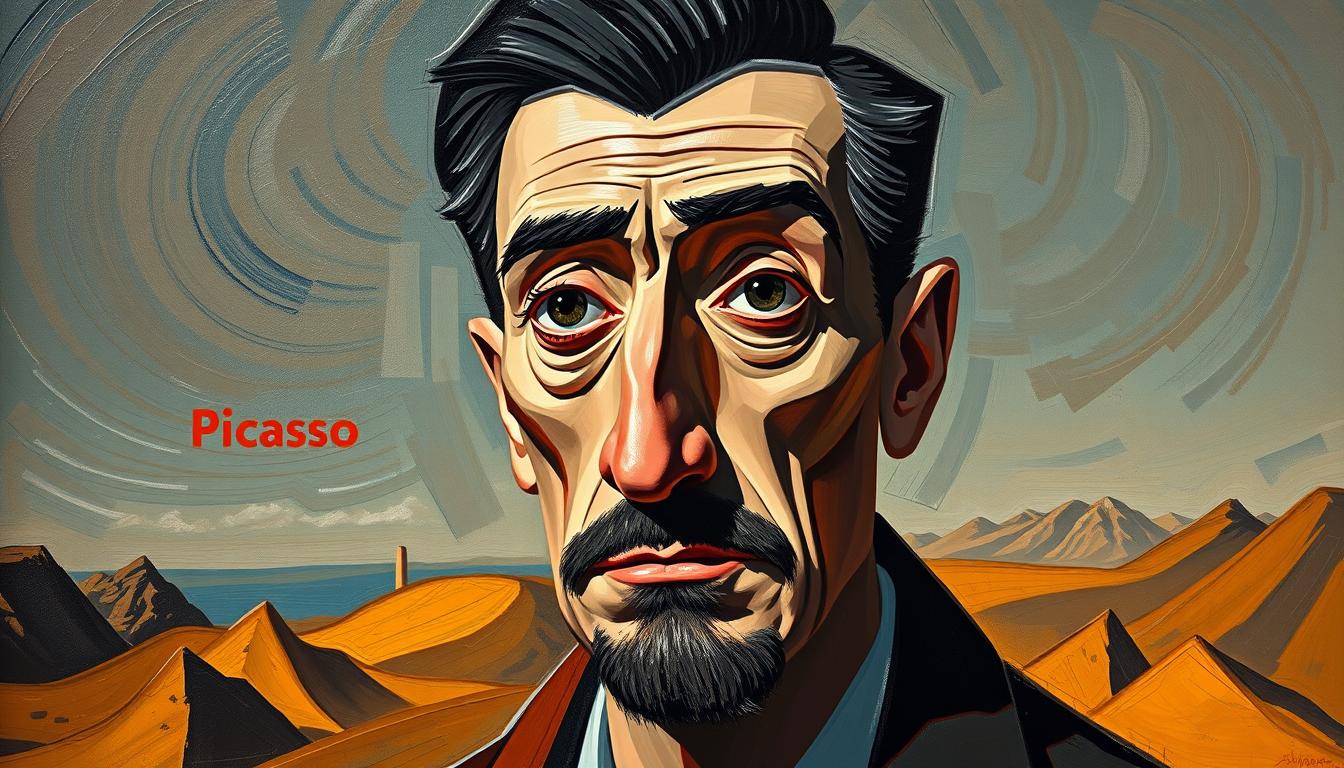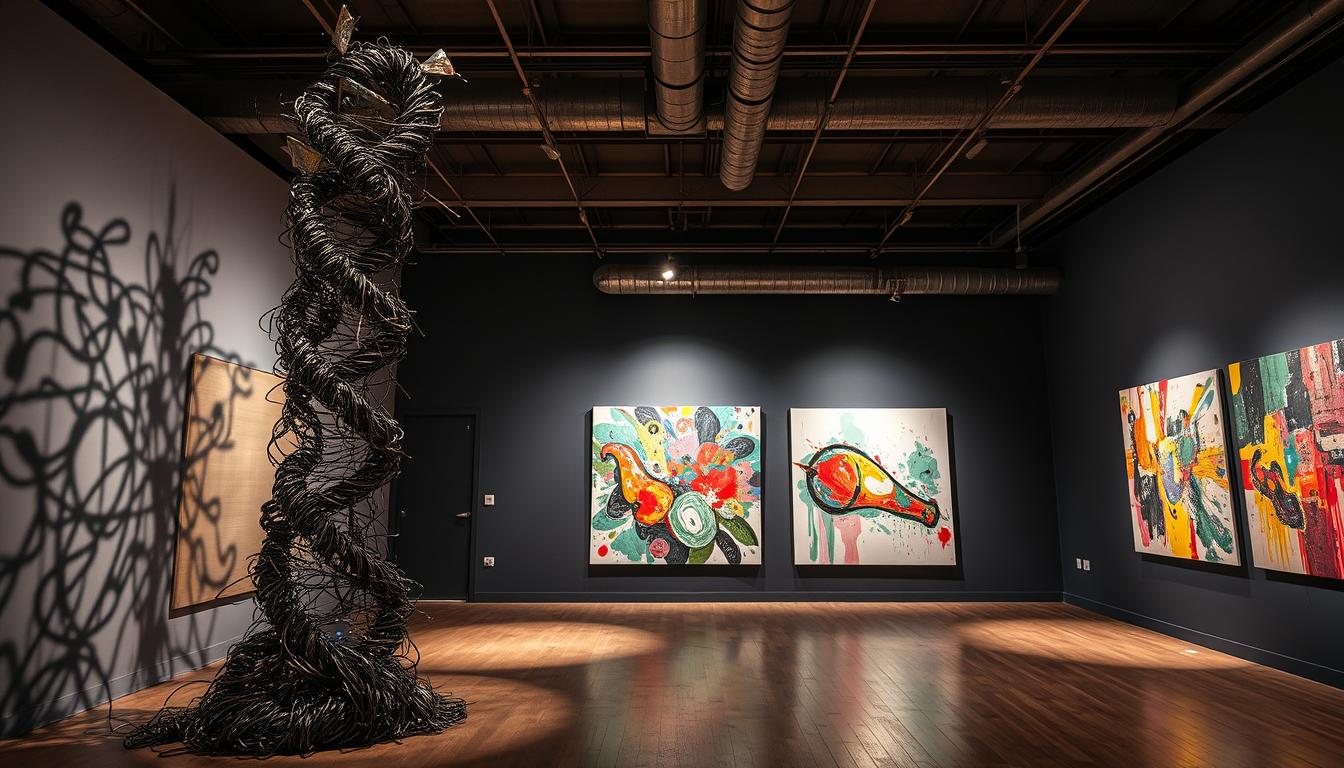Can one of the 20th century’s most experimental painters be called truly non‑representational? This article opens with a clear answer: while pablo picasso pushed painting toward reduction and radical form, he never fully abandoned the imprint of reality.

From academic realism in the 1890s to Cubism after 1907, his work reshaped the way artists saw space and object. The main point is that Cubism tested how much of a subject could be stripped away while still holding meaning.
We will place his experiments in the timeline of modern art history, show how they influenced other movements, and explain why his stance—"you must always start with something"—matters for the broader debate about abstraction.
Key Takeaways
- Pablo Picasso moved from realism to radical simplification but kept ties to the real world.
- Cubism rethought seeing and depiction without becoming pure non‑representation.
- His work influenced many 20th‑century movements while keeping a grounded approach.
- The article maps where his experiments fit in modern art history and why they matter.
- The core idea: reduction can heighten expression without erasing the object.
Is Picasso's art abstract? A clear answer with context
By the 1910s his paintings pushed toward radical simplification, yet they rarely became pure non‑representation. This short section gives a clear answer and the context that shapes it.
Short answer: he pursued abstraction but stopped short of pure abstraction
Short answer: he moved toward abstract art while refusing full detachment from a subject.
Picasso sought reduction in form and lines, but kept markers—like a tie or a pipe—so the viewer could still read a scene.
What “abstract art” means versus his approach
Abstract painting often drops the object entirely. In contrast, his method reduced shapes and emphasized planes while preserving a trace of reality.
That residual trace gives the work a human anchor. Even the most fractured composition leaves a sense of the original subject.
Picasso’s own words: “There is no abstract art… You must always start with something”
“There is no abstract art. You must always start with something. Afterwards you can remove all trace of reality.”
He publicly rejected purely non‑representational work and insisted artists must always start from a point of reference. This stance explains why moments that seem close to pure abstraction never fully abandon form.
For more on his life and practice see the Pablo Picasso biography.
From realism to reduction: how Picasso moved toward abstraction
A solid foundation in realistic painting made his later paring-down a matter of choice and control.
The artist began with careful academic training that produced precise works such as The Old Fisherman (1895). That early skill shows he could render volume and texture when he wanted to.
Primitivism and encounters with African masks, along with Gauguin’s legacy, pushed his forms in a new direction. In Les Demoiselles d’Avignon (1907) the figures become shards: women are built from sharp lines and flat blocks of color. This moment reframed the human body as a set of shapes and planes rather than smooth modeling.

Decades later, the 1945 lithograph The Bull series shows the method at work. Twelve prints trace clear stages from a detailed animal to a spare linear state. Each image removes unnecessary elements while keeping the subject readable.
| Year | Work | Shift |
|---|---|---|
| 1895 | The Old Fisherman | Realistic training; strong draftsmanship |
| 1907 | Les Demoiselles d’Avignon | Proto‑Cubist planes; women as angular shapes |
| 1945 | The Bull (series) | Staged reduction; clarity through removal |
Key point: these works form a clear history of deliberate reduction. Lines, shapes, and careful choices let the artist test the limit of readability while retaining a link to reality.
Cubism’s breakthrough: near‑abstraction without abandoning the object
Cubism forged a new way to show objects by breaking them into overlapping fragments. This approach pushed painting close to non‑representation while keeping a readable subject.

Analytical fragmentation and independent shading
Analytical Cubism split a single object into multiple planes. Each plane could be shaded on its own, so light no longer came from just one source.
Works like Still Life with Bottle of Rum (1911) show how a bottle becomes near‑indiscernible—a field of images and forms rather than a single continuous volume.
Each mark pared back in Cadaqués, summer 1910
During the summer of 1910 in Cadaqués, Picasso reduced marks to gridlike, perpendicular structures. MoMA’s Leah Dickerman noted these pictures “seem abstract in all but name.”
Back in Paris he added tiny attributes—pipes, ties, a curve—to keep the subject legible and to avoid pure abstraction.
Synthetic Cubism: collage and the constructed canvas
Synthetic Cubism brought real materials and flat shapes onto the canvas. Collage made the surface itself meaningful while still starting from real objects.
Debates and influence across movements
While Kandinsky and Mondrian pushed toward non‑representational painting, Picasso insisted on anchoring form to a subject. That stance reshaped modern art history and influenced many later artists.
“These pictures seem abstract in all but name.”
- Analytical Cubism split forms and treated each area’s light separately.
- Cadaqués pushed the work near a state of non‑representation, then shifted back.
- Synthetic Cubism made the canvas a constructed field of shapes and objects.
- The movement reframed how artists thought about line, shape, and image over time.
For a deeper look at the movement, see the Cubism movement.
Conclusion
Across decades of work he tested how far a painting could be pared down while still pointing back to life.
The core point of this article is simple: the artist pushed abstraction but kept a tether to reality. His method left cues so an object or subject stayed readable even when the image felt fractured.
Takeaway: the painter’s phrase that you must always start with something guided each move. Cubism and later works—like the Bull series and early still lifes—show how form, light, and image change on the canvas without erasing objects.
In short, abstraction for him was a tool, not an end. That idea shaped art in its time and still points artists to ways of making work that speak clearly to the world.
Enhance Your Space with Unique Modern Masterpieces
Are you inspired by the innovative mediums and conceptual depth highlighted in our exploration of contemporary art? You’re not alone! Today’s art enthusiasts are seeking cultural relevance and emotional connections in their artwork. However, finding pieces that resonate with modern themes and fit your unique style can be a challenge. That’s where we come in!
At Rossetti Art, we specialize in canvas prints, original paintings, and modern sculptures that celebrate the spirit of now. Each piece created by Chiara Rossetti brings a personal touch that connects deeply with current social narratives—just like the modern masterpieces discussed in the article. Don’t miss out on the chance to elevate your home decor with breathtaking artwork that speaks to your values and aesthetic. Explore our collection today and find your perfect piece! Act now, and transform your space into a gallery of inspiration!
FAQ
Is Picasso's art abstract?
Picasso explored abstraction throughout his career but rarely embraced pure nonrepresentational work. He reduced forms and rearranged space, yet most pieces still reference people, objects, or scenes rather than existing as complete visual inventions.
Did Picasso ever say anything about abstract painting?
Yes. He famously stated, “There is no abstract art. You must always start with something.” That phrase captures his belief that even the most reduced image begins with an observed subject or memory.
How does “abstract” differ from Picasso’s approach to reality and form?
Abstract art often removes recognizable references to focus on pure elements like color, line, or shape. Picasso instead transformed real-world subjects, breaking them into planes, simplifying lines, and reconfiguring perspective while keeping a link to the original object.
What early training shaped his move away from realism?
Trained in classical techniques, Picasso painted realistic portraits and scenes in his youth, such as The Old Fisherman (1895). That solid foundation allowed him to consciously deconstruct and reinvent form later on.
How did primitivism and Proto‑Cubism change his work?
Influenced by African and Iberian sculpture, Les Demoiselles d’Avignon (1907) marks a radical shift: faces and bodies became geometric, lines and planes grew angular, and representation moved toward conceptual fragmentation.
What does The Bull (1945) lithograph series reveal about his process?
The series shows staged reduction: a detailed bull gradually simplifies into fewer lines and shapes. It demonstrates his idea of removing the superfluous while retaining essence, a rehearsal in abstraction without erasing reference.
How did Analytical Cubism push painting toward near‑abstraction?
Analytical Cubism broke objects into intersecting planes and shifted light and shading to read as forms rather than a single viewpoint. Works like Still Life with Bottle of Rum (1911) fragment surfaces while keeping recognizable elements.
Did any period come closest to pure abstraction?
Summer 1910 in Cadaqués produced paintings critics call “abstract in all but name.” Picasso pared down motifs and emphasized flatness, coming very close to nonrepresentational composition but not fully abandoning objecthood.
What role did Synthetic Cubism play in his method?
Synthetic Cubism reintroduced clearer shapes, brighter color, and collage. Rather than inventing forms from nothing, Picasso began with real objects and incorporated found materials, signaling that representation remained central.
How did Picasso’s ideas relate to artists like Kandinsky and Mondrian?
Kandinsky and Mondrian pursued pure abstraction and spiritual or formal purity. Picasso’s Cubism influenced them by expanding what painting could be, yet he kept a tether to the visible world, which set his work apart from pure abstractionists.
Can Picasso’s works be considered abstract art by museum labels?
Museums often place his pieces within modernist and Cubist categories and sometimes tag individual works as near‑abstract. Labels typically emphasize his blend of representation and reduction rather than calling them wholly abstract.
Why does Picasso matter to the history of abstraction?
He pushed the boundaries of form, perspective, and pictorial space. By fragmenting reality and showing new ways to depict objects, Picasso helped create the conditions for later artists to pursue complete abstraction.






Leave a comment
This site is protected by hCaptcha and the hCaptcha Privacy Policy and Terms of Service apply.